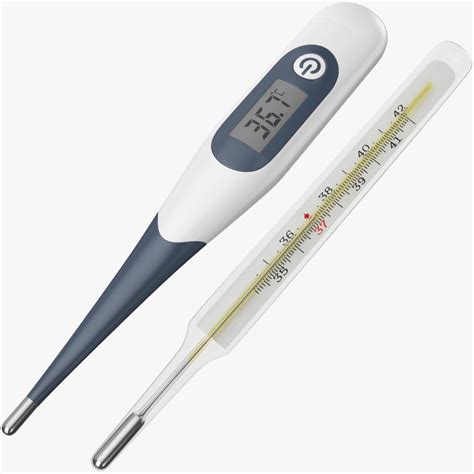The Essential Guide to Thermometers: Ensuring Accurate Temperature Measurement
Types of Thermometers
Thermometers are devices used to measure temperature, which is essential in various fields such as medicine, science, and everyday life. There are several types of thermometers available, each with its unique characteristics.
1. Glass Thermometers: Traditional and Reliable
-
Description: Glass thermometers use a thin glass bulb filled with mercury or alcohol that expands and contracts with temperature changes.
-
Advantages:
- Accurate and reliable when used correctly
- Easy to read and interpret
- Durable and long-lasting
-
Disadvantages:
- Fragile and breakable
- Mercury thermometers can be hazardous due to mercury poisoning
- Slow response time
2. Digital Thermometers: Modern and Convenient
-
Description: Digital thermometers use electronic sensors to measure temperature and display it digitally.
-
Advantages:
- Fast and accurate
- Compact and portable
- Versatile and can measure various temperatures
- Easy to read and use
-
Disadvantages:
- Can be less accurate than glass thermometers
- Requires batteries or power source
- May not be suitable for specialized applications
3. Infrared Thermometers: Non-Contact and Instant
-
Description: Infrared thermometers use infrared technology to measure temperature without physical contact with the object.
-
Advantages:
- Non-contact measurement
- Quick and convenient
- Can be used for both human and object temperatures
- Safe and hygienic
-
Disadvantages:
- May be less accurate than other thermometers
- Can be affected by environmental factors
- More expensive than other types
Tips for Selecting the Right Thermometer
Choosing the appropriate thermometer depends on the specific application. Consider the following factors:
-
Accuracy: The accuracy of a thermometer is determined by its ability to measure temperature within a specific range.
-
Response time: The time it takes for the thermometer to respond to temperature changes is important for quick measurements.
-
Durability: The durability of the thermometer determines its ability to withstand physical damage.
-
Readability: The thermometer should be easy to read and interpret.
-
Versatility: Choose a thermometer that can measure different temperatures and be used in various applications.
Common Mistakes to Avoid
-
Incorrect placement: Ensure the thermometer is placed at the correct location to measure the desired temperature.
-
Interference: Avoid placing the thermometer near heat sources or other objects that may interfere with the temperature reading.
-
Dirty thermometer: Clean and dry the thermometer before and after use to maintain accuracy.
-
Calibration: Calibrate the thermometer regularly to ensure its accuracy.
-
Improper storage: Store the thermometer in a cool, dry place away from direct sunlight.
Step-by-Step Approach to Taking Accurate Temperature
-
Choose the right thermometer: Select the appropriate thermometer based on the required accuracy, response time, and application.
-
Prepare the thermometer: Clean and disinfect the thermometer before use.
-
Place the thermometer correctly: Follow the manufacturer's instructions for proper placement of the thermometer.
-
Allow time for stabilization: Wait an appropriate time for the thermometer to adjust to the temperature being measured.
-
Read and interpret the temperature: Note the temperature reading and interpret it within the context of the specific application.
Pros and Cons of Different Thermometer Types
| Thermometer Type |
Pros |
Cons |
| Glass Thermometers |
High accuracy, durable |
Fragile, slow response time |
| Digital Thermometers |
Fast, easy to read, versatile |
Less accurate, requires power |
| Infrared Thermometers |
Non-contact, quick |
Less accurate, influenced by environmental factors |
Stories and Lessons
Story 1: A hospital patient's diagnosis was delayed due to an inaccurate thermometer. The thermometer was not calibrated properly, leading to an incorrect temperature reading. As a result, the patient received unnecessary antibiotics and prolonged hospitalization.

Lesson: Regular calibration of thermometers is essential to ensure accurate temperature readings, especially in critical applications like healthcare.
Story 2: A chef overcooked a dish because he used an infrared thermometer to measure the temperature of the food. The thermometer was affected by the steam and heat radiating from the stove, resulting in a higher temperature reading than the actual temperature of the food.

Lesson: Consider the environment and potential sources of interference when using infrared thermometers to measure temperature.
Story 3: A hiker suffered hypothermia because his battery-powered digital thermometer ran out of power. The thermometer was not reliable for emergency situations where access to power was limited.

Lesson: Choose a thermometer that is reliable and suitable for the intended use. Consider factors such as durability, battery life, and response time.
Conclusion
Thermometers are indispensable tools in various fields. By understanding the different types of thermometers, their pros and cons, and common mistakes to avoid, you can select and use the appropriate thermometer to ensure accurate temperature measurement. Always prioritize safety, accuracy, and reliability when using thermometers for critical applications like healthcare and scientific research.
